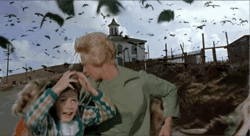So here's what happened... wasn't birds. Pretty cool write up actually:
https://www.thedrive.com/the-war-zo...ed-with-that-washington-d-c-air-defense-scare
From the link above:
"
Our sources tell us that although it is not uncommon for birds to be the cause of false alerts multiple times a month around this time a year, the issue that occurred on the 26th was a radar anomaly that was compounded by human error. One of the radars that feeds data into the integrated air defense system created what is called a "mirror track" of an innocuous and in-contact airplane whose transponder was squawking that it was under visual flight rules (VFR). Because it was a mirror track of just the transponder, there is no primary radar return where the mirror track was, the system pointed it out immediately and started automatically pointing electro-optical camera systems at it to validate the return and to identify what it actually was.
Apparently, the D.C. area's integrated air surveillance system is good enough that transponder tracks alone, where the radar doesn't also have a corresponding hard radar return, nearly never occur. But in this case, it was an anomaly happening within the radar system, not the result of lack of radar coverage or fidelity.
When the cameras pointed at the mirror track's location, they saw a real plane that was located roughly along the same azimuth as the mirror track. The issue is that since cameras cannot quantify range, it validated that something
was there, but in reality, that plane was not at the range the radar showed the mirror track to be, it was much farther away. In other words, if a plane was actually where the mirror track should have been, the cameras would have seen two airplanes, not just one. As a result of this confusion, more cameras started being pointed at the target automatically.
At this time, the mirror track faded away, so the cameras had no automated radar data left to point to. Human operators took over and they started manually scanning the area for something that wasn't there anymore. There have been reports of ‘blobs’ being seen by the air defense system operators during this instance. Our sources made it clear that this is anything but uncommon as looking into the sky with long focal length cameras results in blobs, especially when scattered clouds are present. There is simply nothing substantial or defining to look at.
"




